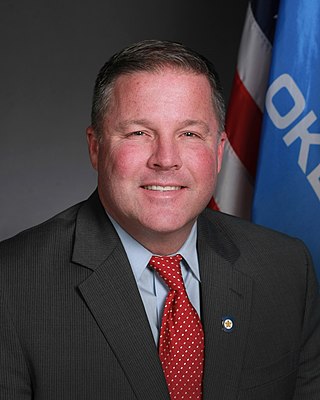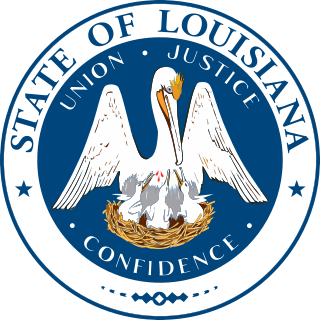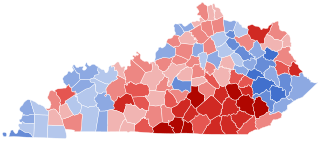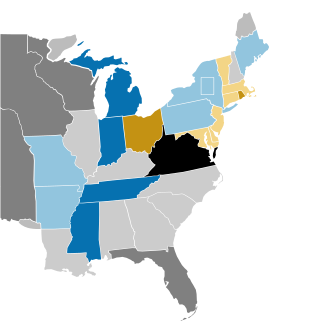
President of the Senate is a title often given to the presiding officer of a senate. It corresponds to the speaker in some other assemblies.

The Georgia General Assembly is the state legislature of the U.S. state of Georgia. It is bicameral, consisting of the Senate and the House of Representatives.

The Colorado State Senate is the upper house of the Colorado General Assembly, the state legislature of the US state of Colorado. It is composed of 35 members elected from single-member districts, with each district having a population of about 123,000 as of the 2000 census. Senators are elected to four-year terms, and are limited to two consecutive terms in office. Senators who are term-limited become eligible to run again after a one-term respite.

The lieutenant governor of Texas is the second-highest executive office in the government of Texas, a state in the U.S. It is the second most powerful post in Texas government because its occupant controls the work of the Texas Senate and controls the budgeting process as a leader of the Legislative Budget Board.

The Lieutenant Governor and Speaker of the Senate of Tennessee is the presiding officer of the Tennessee Senate and first in line in the succession to the office of governor of Tennessee in the event of the death, resignation, or removal from office through impeachment and conviction of the governor of Tennessee.
The following table indicates the party of elected officials in the U.S. state of Ohio:

The treasurer of the U.S. state of Ohio is responsible for collecting and safeguarding taxes and fees, as well as managing state investments. The Treasury was located in the Ohio Statehouse from 1861 to 1974, when it was moved to the Rhodes State Office Tower. The original office in the statehouse, which has been restored to its 19th-century appearance, is used for ceremonial events.

The Georgia State Senate is the upper house of the Georgia General Assembly, in the U.S. state of Georgia. The Georgia State Senate and the lower house of the General Assembly, the Georgia House of Representatives, comprise the bicameral legislature of the state. Together, the Senate and the House maintain authority under Article III. of the 1983 Constitution of Georgia to enact laws "necessary and proper for the welfare of the state", although state law is subordinate to the state constitution, the United States Constitution, and federal law.
New York is a Democratic stronghold and is considered one of the "Big Three" Democratic strongholds alongside California and Illinois. The following table indicates the party of elected officials in the U.S. state of New York:

President Pro Tempore of the Kentucky Senate was the title of highest-ranking member of the Kentucky Senate prior to enactment of a 1992 amendment to the Constitution of Kentucky.

The lieutenant governor of Nebraska is the highest-ranking executive official in the State of Nebraska after the governor. According to the Nebraska State Constitution, in the event a governor dies, becomes permanently incapacitated, resigns, or is removed from office, the lieutenant governor will become governor.

The Nevada Senate is the upper house of the Nevada Legislature, the state legislature of U.S. state of Nevada, the lower house being the Nevada Assembly. It currently (2012–2021) consists of 21 members from single-member districts. In the previous redistricting (2002–2011) there were 19 districts, two of which were multimember. Since 2012, there have been 21 districts, each formed by combining two neighboring state assembly districts. Each state senator represented approximately 128,598 as of the 2010 United States census. Article Four of the Constitution of Nevada sets that state senators serve staggered four-year terms.

The president pro tempore of the Oklahoma Senate is the second-highest-ranking official of the Oklahoma Senate and the highest-ranking state senator. The Oklahoma Constitution designates the Lieutenant Governor of Oklahoma as the highest-ranking official, serving ex officio as President of the Senate, even though the lieutenant governor only votes in the case of a tie. During the lieutenant governor's absence, the president pro tempore presides over sessions. By longstanding custom, the lieutenant governor presides over sessions devoted to ceremonial purposes, while the bulk of the legislative management and political power is reserved for the president pro tempore, who is elected directly by the Oklahoma Senate.

The Louisiana State Senate is the Upper House of the State Legislature of Louisiana. All senators serve four-year terms and are assigned to multiple committees.

The Iowa Senate is the upper house of the Iowa General Assembly. There are 50 seats in the Iowa Senate, representing 50 single-member districts across the state of Iowa with populations of approximately 60,927 per constituency, as of the 2010 United States census. Each Senate district is composed of two House districts. The Senate meets at the Iowa State Capitol in Des Moines.

The lieutenant governor of Indiana is a constitutional office in the US state of Indiana. Republican Suzanne Crouch, who assumed office January 9, 2017, is the incumbent. The office holder's constitutional roles are to serve as the president of the Indiana Senate, become acting governor during the incapacity of the governor, and become governor should the incumbent governor resign, die in office, or be impeached and removed from office. Lieutenant governors have succeeded ten governors following their deaths or resignations. The lieutenant governor holds statutory positions, serving as the head of the state agricultural and rural affairs bureaus, and as the chairman of several state committees.

The following table indicates the party of elected officials in the U.S. state of Kentucky:
The following table indicates the party of elected officials in the U.S. state of Louisiana:

The 1876–77 United States Senate elections were held on various dates in various states, coinciding with Rutherford B. Hayes's narrow election as president. As these U.S. Senate elections were prior to the ratification of the Seventeenth Amendment in 1913, senators were chosen by state legislatures. Senators were elected over a wide range of time throughout 1876 and 1877, and a seat may have been filled months late or remained vacant due to legislative deadlock. In these elections, terms were up for the senators in Class 2.

The 1844–45 United States Senate elections were held on various dates in various states, coinciding with James K. Polk's election. As these U.S. Senate elections were prior to the ratification of the Seventeenth Amendment in 1913, senators were chosen by state legislatures. Senators were elected over a wide range of time throughout 1844 and 1845, and a seat may have been filled months late or remained vacant due to legislative deadlock.

















